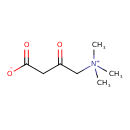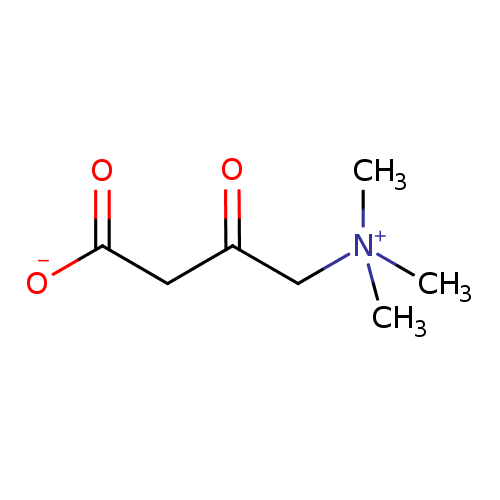|
Record Information |
|---|
| Version |
1.0 |
|---|
| Update Date |
1/22/2018 11:54:54 AM |
|---|
|
Metabolite ID | PAMDB110188 |
|---|
|
Identification |
|---|
| Name: |
3-dehydrocarnitine |
|---|
| Description: | An ammonium betaine that is the conjugate base of 3-dehydrocarnitinium; major species at pH 7.3. |
|---|
|
Structure |
|
|---|
| Synonyms: | |
|---|
|
Chemical Formula: |
C7H13NO3
|
|---|
| Average Molecular Weight: |
159.18 |
|---|
| Monoisotopic Molecular
Weight: |
160.0973683209 |
|---|
| InChI Key: |
YNOWULSFLVIUDH-UHFFFAOYSA-N |
|---|
| InChI: |
InChI=1S/C7H13NO3/c1-8(2,3)5-6(9)4-7(10)11/h4-5H2,1-3H3 |
|---|
| CAS
number: |
10457-99-5 |
|---|
| IUPAC Name: | 3-oxo-4-(trimethylazaniumyl)butanoate |
|---|
|
Traditional IUPAC Name: |
3-dehydrocarnitine |
|---|
| SMILES: | C(C(=O)CC(=O)[O-])[N+](C)(C)C |
|---|
|
Chemical Taxonomy |
|---|
|
Taxonomy Description | This compound belongs to the class of chemical entities known as short-chain keto acids and derivatives. These are keto acids with an alkyl chain the contains less than 6 carbon atoms. |
|---|
|
Kingdom |
Chemical entities |
|---|
| Super Class | Organic compounds |
|---|
|
Class |
Organic acids and derivatives |
|---|
| Sub Class | Keto acids and derivatives |
|---|
|
Direct Parent |
Short-chain keto acids and derivatives |
|---|
| Alternative Parents |
|
|---|
| Substituents |
- Beta-keto acid
- Short-chain keto acid
- 1,3-dicarbonyl compound
- Alpha-aminoketone
- Tetraalkylammonium salt
- Quaternary ammonium salt
- Carboxylic acid salt
- Ketone
- Carboxylic acid derivative
- Carboxylic acid
- Monocarboxylic acid or derivatives
- Organic nitrogen compound
- Organonitrogen compound
- Organooxygen compound
- Organic salt
- Hydrocarbon derivative
- Organic oxide
- Organopnictogen compound
- Carbonyl group
- Organic oxygen compound
- Amine
- Aliphatic acyclic compound
|
|---|
| Molecular Framework |
Aliphatic acyclic compounds |
|---|
| External Descriptors |
|
|---|
|
Physical Properties |
|---|
| State: |
Solid |
|---|
| Charge: | 0 |
|---|
|
Melting point: |
Not Available |
|---|
| Experimental Properties: |
| Property | Value | Reference |
|---|
| Melting Point | Not Available | Not Available | | Boiling Point | Not Available | Not Available | | Water Solubility | Not Available | Not Available | | LogP | Not Available | Not Available |
|
|---|
| Predicted Properties |
|
|---|
|
Biological Properties |
|---|
| Cellular Locations: |
Not Available |
|---|
| Reactions: | |
|---|
|
Pathways: |
- Carnitine Catabolism to Glycine BetainePWYB-96
|
|---|
|
Spectra |
|---|
| Spectra: |
Not Available |
|---|
|
References |
|---|
| References: |
- Goedert JJ, Sampson JN, Moore SC, Xiao Q, Xiong X, Hayes RB, Ahn J, Shi J, Sinha R (2014)Fecal metabolomics: assay performance and association with colorectal cancer. Carcinogenesis 35, Pubmed: 25037050
- Kleber HP, Schöpp W, Sorger H, Tauchert H, Aurich H (1967)[Formation of 3-dehydrocarnitine from L-carnitine through the action of a Pseudomonas aeruginosa enzyme] Acta biologica et medica Germanica 19, Pubmed: 4968678
|
|---|
| Synthesis Reference: |
Not Available |
|---|
| Material Safety Data Sheet (MSDS) |
Not Available |
|---|
|
Links |
|---|
| External Links: |
|
|---|


